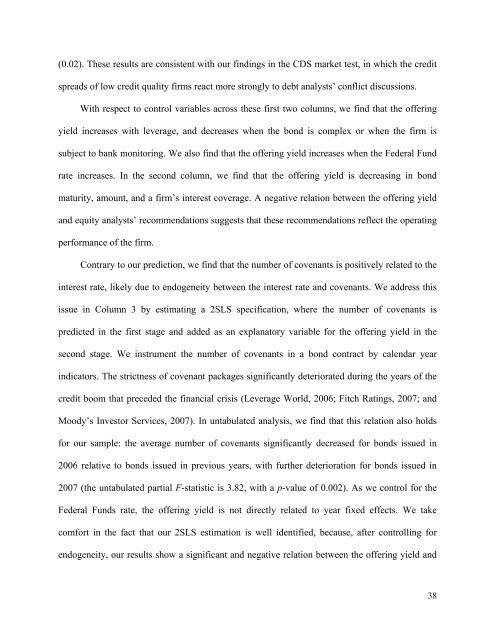Debt Analysts' Views of Debt-Equity Conflicts of Interest
Debt Analysts' Views of Debt-Equity Conflicts of Interest
Debt Analysts' Views of Debt-Equity Conflicts of Interest
You also want an ePaper? Increase the reach of your titles
YUMPU automatically turns print PDFs into web optimized ePapers that Google loves.
(0.02). These results are consistent with our findings in the CDS market test, in which the credit<br />
spreads <strong>of</strong> low credit quality firms react more strongly to debt analysts’ conflict discussions.<br />
With respect to control variables across these first two columns, we find that the <strong>of</strong>fering<br />
yield increases with leverage, and decreases when the bond is complex or when the firm is<br />
subject to bank monitoring. We also find that the <strong>of</strong>fering yield increases when the Federal Fund<br />
rate increases. In the second column, we find that the <strong>of</strong>fering yield is decreasing in bond<br />
maturity, amount, and a firm’s interest coverage. A negative relation between the <strong>of</strong>fering yield<br />
and equity analysts’ recommendations suggests that these recommendations reflect the operating<br />
performance <strong>of</strong> the firm.<br />
Contrary to our prediction, we find that the number <strong>of</strong> covenants is positively related to the<br />
interest rate, likely due to endogeneity between the interest rate and covenants. We address this<br />
issue in Column 3 by estimating a 2SLS specification, where the number <strong>of</strong> covenants is<br />
predicted in the first stage and added as an explanatory variable for the <strong>of</strong>fering yield in the<br />
second stage. We instrument the number <strong>of</strong> covenants in a bond contract by calendar year<br />
indicators. The strictness <strong>of</strong> covenant packages significantly deteriorated during the years <strong>of</strong> the<br />
credit boom that preceded the financial crisis (Leverage World, 2006; Fitch Ratings, 2007; and<br />
Moody’s Investor Services, 2007). In untabulated analysis, we find that this relation also holds<br />
for our sample: the average number <strong>of</strong> covenants significantly decreased for bonds issued in<br />
2006 relative to bonds issued in previous years, with further deterioration for bonds issued in<br />
2007 (the untabulated partial F-statistic is 3.82, with a p-value <strong>of</strong> 0.002). As we control for the<br />
Federal Funds rate, the <strong>of</strong>fering yield is not directly related to year fixed effects. We take<br />
comfort in the fact that our 2SLS estimation is well identified, because, after controlling for<br />
endogeneity, our results show a significant and negative relation between the <strong>of</strong>fering yield and<br />
38
















